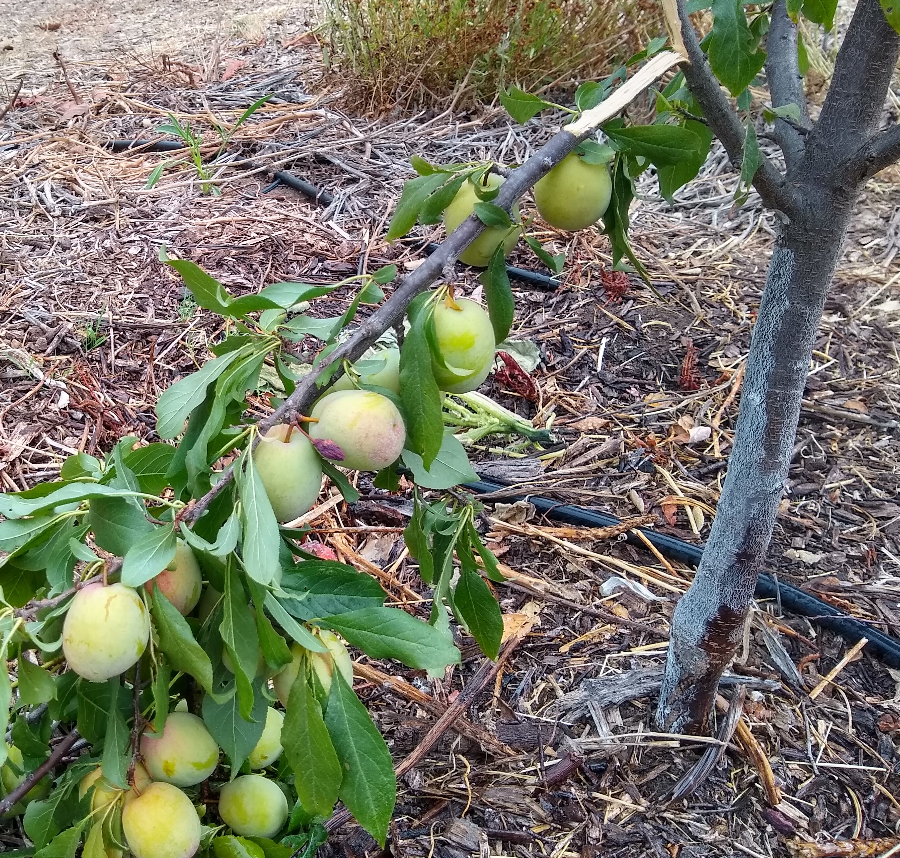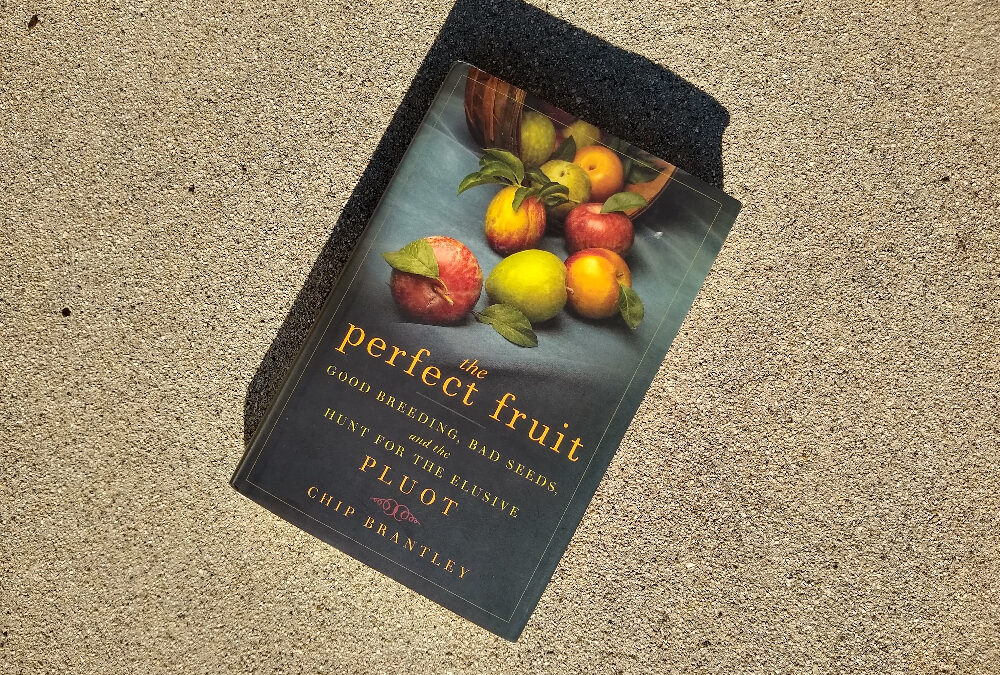Growing up, I liked plums. In the summer, I would jump out of the swimming pool at my grandparents’ house to eat a few from their tree. Once I had a yard of my own that came with a plum tree, I was angry when squirrels stole most of them. But I have never planted a new plum tree.
I have, however, planted numerous pluot trees. (Plum + Apricot = Pluot.) They are my favorite stone fruit.
My brother calls pluots: “plums perfected.” Chip Brantley wrote a book called, The Perfect Fruit: Good Breeding, Bad Seeds, and the Hunt for the Elusive Pluot.
It’s a conversion story and a story of discovery. Brantley was bouncing around trying to find his way in life when he met Elizabeth, who would become “the one,” and then a few weeks later he met pluots. “All of my earlier dabbling felt like preparation for this moment . . . I felt compelled to know everything about pluots . . . They were my Thing.”
The Perfect Fruit is the product of a young man with an obsession who turned his inexhaustable zeal for all things pluot into a benefit for the rest of us. He could have just gobbled up the fruit and learned about their history and met the farmers who grew them, but instead he kept notes and wrote a book which I just gobbled up for the second time.
I had read The Perfect Fruit some years back. It was published in 2009. A couple weeks ago, I picked it off my shelf, opened it up and then couldn’t stop reading. I enjoyed the book even more this second round.
Brantley takes you on a famous fruit tasting tour of Zaiger Genetics, and you get to know Floyd Zaiger, who bred the pluots we grow today. Get to know Luther Burbank as well, who crossed plums and apricots before Zaiger.

Take many drives with Brantley around California’s Central Valley, where all of the pluot action takes place. Brantley gives the reader a sharp sense of what the Valley looks and feels like. You may have driven along the 5 to the Bay Area or along the 99 to the Sierras but have not known the story of the trees that line the shoulders, some of which are pluots.
Brantley also brings you into conversations with farmers of pluots and their internal marketing struggles, harvesting challenges, and even family squabbles. Brantley puts human faces on the vast acreage of Central Valley fruit trees.
Brantley himself is a writer, not a grower. Nevertheless, he gets all of the horticulture stuff right. It is a pleasure to read someone who is gifted with words and narrative while simultaneously careful about the accuracy of technical details.

To me, the most interesting farmer in the book is Rob Mazuna. He is a small-time operator, on only ten acres, but “his orchard was like a . . . stone fruit’s greatest hits.” He sold his peaches and pluots at a farmer’s market so he wasn’t restricted to varieties that had large size or could be picked green or had showy skin colors. He grew the best eating varieties only. “I just plant what I like and when it’s time to pick for the market, I pick what’s ready,” said Mazuna.
Mazuna celebrates flavor, the eating of pluots, and this book by Chip Brantley is, overall, a celebration of eating the best fruit.
A number of farmers in Brantley’s book name Flavor King as the best pluot variety even though none of the large-scale farmers grow it to sell because it doesn’t have the commercial qualities they need. One farmer, Rod Milton, nevertheless keeps thirty trees of Flavor King on his farm. “I’ve got to have it. I’ve just got to have it,” he says.
I grow Flavor King. It is that good. My grandmother grows Flavor King, because it’s that good. Try finding some at a farmer’s market in August; otherwise, grow your own. It might be the perfect fruit.

Here are links to Chip Brantley’s The Perfect Fruit at Barnes and Noble and Amazon.
You might also like to read my post on Floyd Zaiger, who passed away in 2020, and my post on Highway 99.
Also check out my post: “Growing pluots in Southern California.” Within it is a video profile I made of the Flavor King and Dapple Dandy varieties.
All of my Yard Posts are listed HERE
I hope you find my Yard Posts helpful, and I appreciate your support so I can continue to make them.




Hey Greg, you said you just got 6 yards of compost delivered…..where did you get it from? Does anyone else have a compost place they trust and love?
Hi Terri,
The compost came from IPRR in Lakeside, San Diego County. It’s my first time using their compost but it looks, feels, and smells right, their prices were reasonable, and they were very easy to work with. Here is their website: https://iprrgreen.com/
I know other home gardeners and farmers who really like the compost they get from AgriService (El Corazon) in Oceanside: https://agriserviceinc.com/
Wow, thanks for telling me, Greg, I’m in El Cajon so this is perfect!
I grow Flavor King. It is that good.
It’s been a real bear to grow tomato seedlings with so much rain and cold. Not that I’m complaining, rain gods! Have some that would ordinarily be ready for the garden but I’m scared to plant with the temps forecast for Orange County in the coming days. In the meantime, got some gigantic weeds (ragweed?) that make puffy seed pods little wild birds seem to love. Almost hate to pull them out to make way for maters.
I’m also worried that any transplants won’t take root easily with all the rain. Any thoughts on that? I’ll wait til it dries up. Also, worried about walking around and compacting the soil and ruining its structure too much when it’s really wet.
Hi Brian,
This varies yard to yard. In my yard, I’ve got wood chips covering the paths between my vegetable beds so I don’t hesitate to walk on it even when wet because I’ve seen over the years that the wood chips protect from compaction. But maybe with a more clay soil that wouldn’t be the case, I’m not sure.
Hi Randy,
I’m in a similar situation with a bed of mustard that has gone to flowers, which the bees love. I need it for tomatoes, but I hate to take it away from the bees.
Speaking of cold temps, I just lost about 70 tomato seedlings here in Northeast Fallbrook. Also lost about 10 plants that were 3+ weeks in the ground.
Our microclimate dipped below 31 on April 4th and to around 32 on the 5th. Mother Nature got me, I thought I was safe. My little avos got singed pretty good as well. Bacon is holding up like a champ tho, showing no signs of stress after we dipped to 28. Hass and lamb not so much.
Hopefully a great season for stonefruit tho.
Pluot is pretty close to being the perfect fruit for the summer. I’ve always though it tastes more like plum than apricot until I’ve tasted flavor grenade and emerald drop I’ve bought from Jimbo’s grocery. They are so good that I’ve bough a multi-graft one from walter andersen (flavor grenade/emerald drop/geo-pride/splash). Also haven’t taste aprium but I also got a flavor delight.
My wife’s current favorite is Dapple Dandy. The flavor king hasn’t set fruit in the past but I expect it to this year. Her previous favorite was emerald drop. I like all stone fruits, but for me, an old fashioned juicy giant yellow peach fresh off the tree on a warm summer day is hard to beat.
I’ve just got to have it too.
I think the only fruit better than a Flavor King, is the SpiceZee Nectaplum. With the excellent winter, I am hoping all my Pluots and Nectaplums (I have 3 now) make huge crops 😀